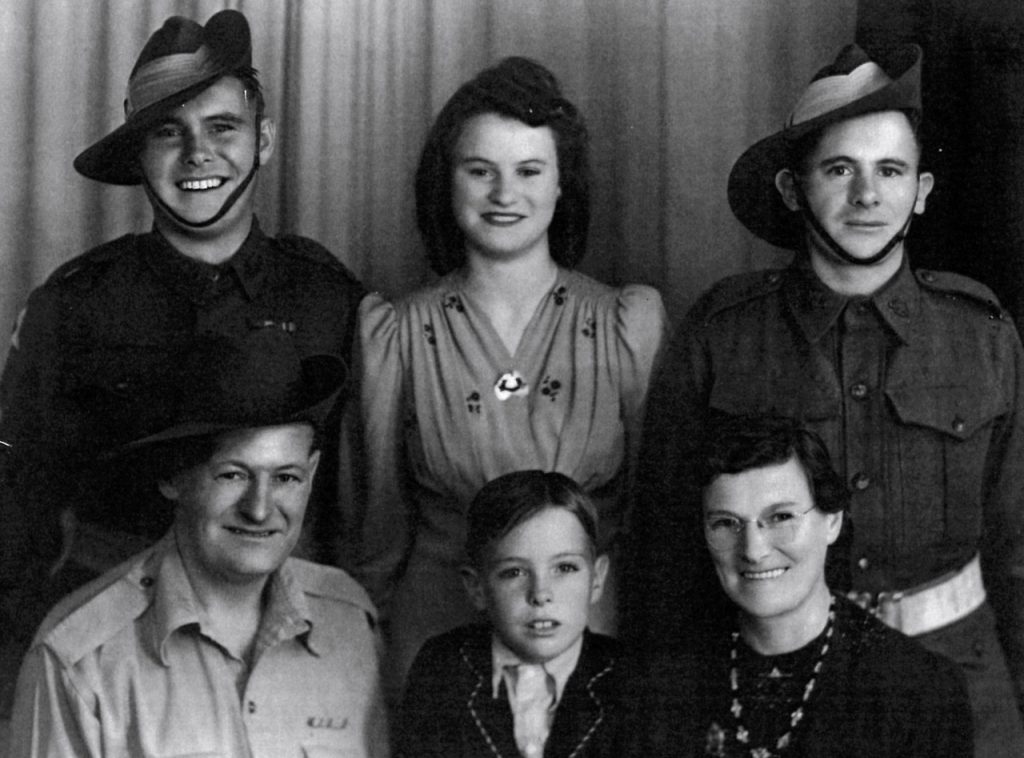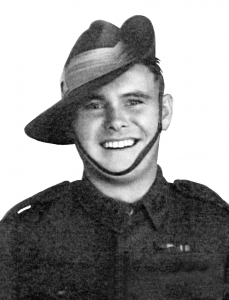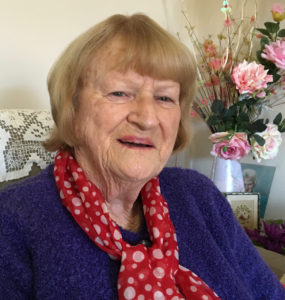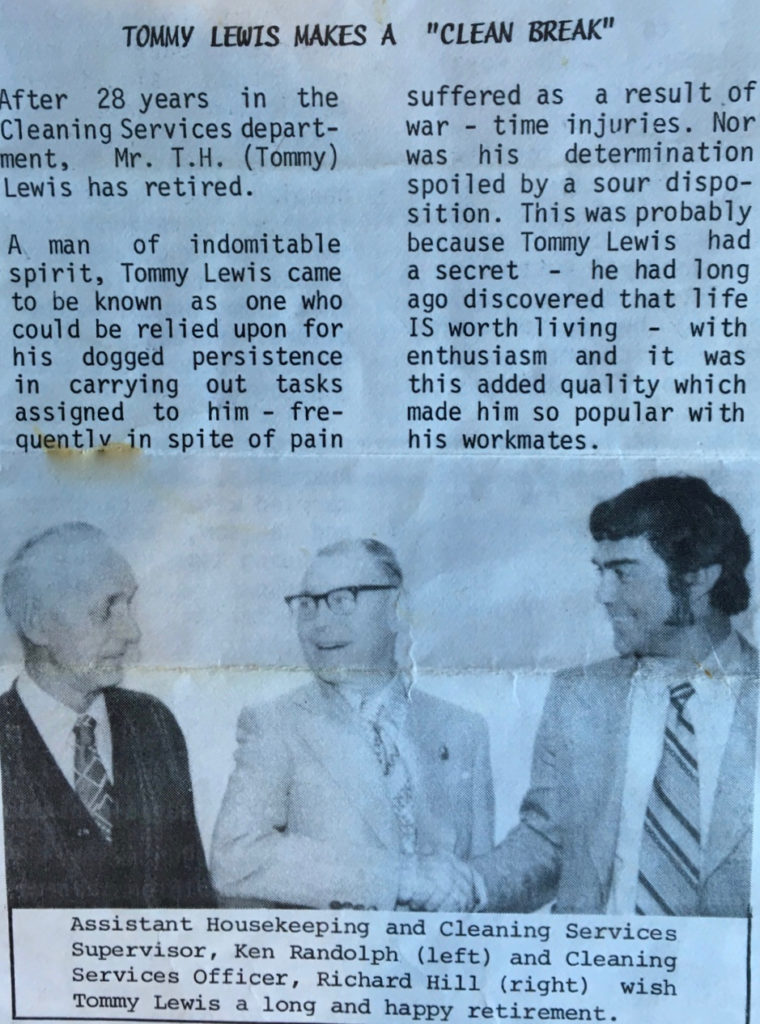
Back row: Tom, Gwen, John. Front row: Richard, Len and Margaret

Tom Lewis with his wonderful smile!
The following is the story of Tom Lewis of his bravery and sheer determination!
Looking into Tom’s photograph taken before he left for Singapore, we see a face that appears to smile so easily and perfectly. His eyes seem to smile back, We think to ourselves how wonderful to have such an engaging, smiling face and those beautiful teeth!
He returned home knowing he would never again experience the joys we all take for granted. Enjoying good physical health, perhaps marriage, having a family, attending sporting games, functions. Life’s every day events. He would never be able to tell a joke or share a chat with a mate over a beer.
Tom returned to Western Australia at war’s end from hospital in Singapore, unable to walk and with minimal voice.
This is his story as told by his loving sister Gwen Lewis in January 2018.
The Lewis family migrated to Western Australia when Tom was 2-3 years old and younger brother John a baby. Under our State Government’s Group Settlement Scheme the Lewis family took up virgin land at Karridale, an area known as Nilup (today known as Alexander Bridge).
Richard and Margaret Lewis worked very hard and long hours clearing their land, establishing a home. Their family increased with the births of Howell, Gwen and Len. Like many families they were isolated from family and friends and no doubt came to rely on their small community and neighbours.
Richard Lewis had served with British Forces in WW1. He was a machine gunner and whilst serving in France met Australian soldiers. Perhaps the reason the family decided to move to WA. Richard was employed in Wales as a successful farm manager so it had been a decision of wanting to migrate to Australia.
When Howell was about 3 years old he became seriously ill. The nearest doctor was at Margaret River. His mother Margaret had no option but to take Len. They drove 18 miles to catch the train at Karridale to Margaret River where the doctor informed her, ‘Howell has a cold and to take him home’. Her return journey with a sick child was just as long and challenging. Howell’s health continued to deteriorate and a few days later the family were devastated when he died. Margaret’s grief understandably, was deep and very dark. She was unable to look after the children and Tommy was sent to stay with friends in Busselton for awhile.
Howell Lewis died of meningitis, an illness of which so little was known about then.
When John was about 9 or 10 he fell off a picket fence. He extensively splintered his leg and the injury was so serious he was to spend almost the next two years recovering as a patient at Lady Lawley Hospital for Children in Cottesloe. Gwen recalls the excitement she and Tom experienced when their younger brother John sent them a penny coin to share! For young John it would have been a terrible time being so far from his parents and family – nor would they have they been able to visit very often. When John returned home his siblings found a stranger and certainly, John would have been more than challenged to return to his family at the farm after 2 years away. In later life, John was very disappointed to find his was unable to enlist with the forces – because of his childhood injury.
After returning home from Lady Lawley hospital, John found his way in the world by becoming a highly skilled horseman, and was a successful entrant in horse events. He suffered another health scare when he was kicked by a draught horse, which left him unconscious!
He eventually enlisted with Light Horse and successfully achieved a transfer to AIF during the later years of the war, when the military lifted a lot of the initial conditions such as age and health.
The Lewis family decided to leave their property and Karridale – Margaret felt she and her family had endured their fair share of heartache. The older children had completed their education at Nilup, Gwen was 7 years old and Len the youngest, was about to begin school for the first time. Gwen was the only girl at her school and in fact in the district! Richard Lewis knew it was time to leave when he found his 7 year old daughter had been training to learn boxing at school with the boys! It was time to move to the city.
Work was not easy to find during the depression years. Both Richard and his eldest son Tom who would have been about 14 or 15 years old, found work in farming. Richard was working at Bruce Rock and Tom was also away working on a farm.
When war broke out and Tom decided to enlist, he found himself in the same line-up with a former schoolmate from Nilup. It was Bill Attenborough whose mother had sought work at Karridale when Bill was about 8 years old. Tom and Bill had not seen each other since Tom left Karridale, but the two young men quickly resumed their friendship when they joined the 2/4th. Bill Attenborough was considered to be one of the Lewis family and was often at the family home. Other 2/4th boys to visit regularly call into the Lewis family home included Tom Fotheringham, ‘Paddy’ (George) Glass and Frank Clark. Frank’s family owned and ran the general store at Alexander Bridge.
Whilst the 2/4th was training and living at Northam, Tom Lewis was part of the boxing team and was light weight champion.
Tom’s father Richard also enlisted. He joined the Reservist Army and worked at the camps where the Italian POWs were interned.
Whilst a POW at Changi, Tom Lewis contracted Ross River encephalitis from mosquito bites and lapsed into unconsciousness. His condition became so serious Dr. Bruce Hunt fought to resuscitate him several times to keep him alive. When Tom did regain consciousness several weeks later he was not able to speak and barely able to walk with the left side of his body paralysed. Worse still, Tom was not able to recall his former life. He knew nothing about himself or his name.
Tom’s mates rallied around to assist and visited when they could. Bill Attenborough spent all his free time beside his best mate’s bed. He was selected with ‘B’ Force to go to Borneo. Bill probably could have arranged a swap, but doctors treating Tom said his condition was so serious they did not expect him to survive. Bill Attenborough did not want to see Tommy, his best mate, die. He chose to leave Singapore and sail to Borneo. Bill said farewell to Tommy. Also departing with ‘B’ Force was Tom Fotheringham. Tragically neither Tom nor Bill survived Sandakan. In fact more then 2,000 Australian POWs died. 6 survived after incredible and difficult escapes, but their health and lives never seemed to be ideal.
Amongst those who knew of Tom’s condition was Johnny Gilmour who was also a patient at the hospital at that time. Before he departed for Japan, Johnny was one of many who assisted Tom in learning to talk again. Following on from John Gilmour, other patients would take over the task of helping and tutoring Tom.
Whilst at Changi hospital Tom developed bedsores that became so advanced part of the bones in his feet became exposed. This became another hurdle for Tommy to overcome as doctors feared he would require amputation.
While Tom began the slow process of learning to speak and walk at Changi hospital, his mates were being selected for various work parties and leaving Singapore. Tragically Bill Attenborough and Tom Fotheringham died at Sandakan and Frank Clark died of illness at Kuii Camp in August 1943.
At war’s end Tom Lewis returned to Perth where he was to spend much time at Hollywood Hospital. Tom could neither walk nor speak with an audible voice easily understood.
Of course Tom was able to hear but he eventually found it too difficult to attend 2/4th reunions and became despondent when old mates seemed not to understand him or his speech problem. Tom felt they were not prepared to spend the time necessary to listen and understand and he found he was mostly pressed to write notes of communication. He was devastated. In those early days being back home, the’ boys’ were probably trying to cope with their own problems fitting into life, families, work and dealing with their own physical and emotional problems and when gathered as a group, there would have been a lot of sky-larking, loud voices and excitement as they unknowingly reached out to each other!
When he was finally discharged from Hollywood Repatriation hospital and returned to his parent’s family home in Leederville, Tom spent a great amount of time with his only sister Gwen. He seemed very unsure of himself and became reliant upon her. Gwen had been 12 years of age when Tom left Australia. She was now 16 and would help him to stand and walk. Brother and sister became very close.
Tom who had been in good physical condition when he left Australia; a young man in the prime of his life, who was a fit boxer, who loved to sing, dance and work physically was now a shadow of his former self.
Worse was to follow for Gwen, her mother and family. The families of the soldiers who did not return, would make hurtful comments – they felt having a son like Tom to care was a far worse experience than their losses!
As on ongoing side effect of encephalitis Tommy suffered epileptic fits from time to time. He regained his speech however his voice was a soft whisper and it would take him a few seconds to speak.
Eventually Tom was able to take up a job as a cleaner at Royal Perth Hospital. He is to be commended for undertaking this job for 28 years! Throughout his life Tom always found his inability to speak in an audible voice a liability at work and socially.
He applied for and was refused TPI! So Tommy was forced to continue working.
In his later years Tom loved to visit his brother John, his wife and family who had managed a small holding at Serpentine. Tom would love to spend weekends with them and renew his love and affinity with the land; not so far from where he lived his formative years at Karridale.
Gwen recalls Tom always seemed to overcome the very low periods in his life, and certainly there were moments when he may have easily given up on life but something seemed to get him through to the other side. Tommy was a man of considerable bravery and strength.
On the whole Tom was happy and always smiled!
His loved his mother (his father passing away years earlier) his family, nieces and nephews and in his final years Tom met a woman who meant much to him and with whom he was happy, and enjoyed her company.
Tommy’s retirement.
Tom died aged 58 years in 1978. His death was sudden and without pain at his home. He was buried at Karrakatta with his parents.
Life had not been fair to Tom Lewis.
“Tom was always sick and always smiling,” says Gwen who today is nearly 90 years old. Now Mrs. Gwen Linto, she has been a member of the 2/4th Association and has regularly and generously donated in memory of her brother Tom and his mates in the 2/4th.
We thank you Gwen for your continuing generosity, and in particular your donation to the 2/4th website, our memorial to the men of the 2/4th.
We also thank you for sharing Tom’s life with us.

Mrs Gwen Linto, July 2018

